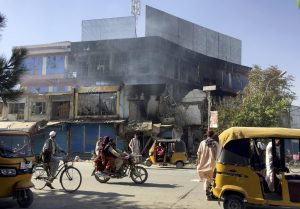Catherine Putz

On August 6, the first Afghan provincial capital fell to the Taliban in the wake of the nearly-complete U.S. withdrawal and intensified fighting across the country. By August 9, three other provincial capitals had reportedly fallen, too, with an additional major city teetering on the brink.
Zaranj, the capital of southwestern Nimroz province, was the first to fall. Zaranj is one of Afghanistan’s smaller provincial capitals, but reports of its fall to the Taliban were a blow to government hopes to keep the Taliban from seizing provincial centers. Nimroz, which borders Iran, also borders Helmand province where the Afghan security forces have been deeply engaged in keeping the Taliban from seizing Lashkar Gah, Helmand’s capital.
According to the BBC, Nimroz’s Deputy Governor Roh Gul Khairzad told reporters that Zaranj had been under threat for a while, “but no one from the central government listened to us.” The city, she said, fell “without a fight.”
Sheberghan, the capital of the northern province of Jawzjan, fell the next day after a week of clashing between local government forces and the Taliban. According to TOLO News reports, government security forces now only hold the provincial airport in the Khwaja Dako district. Jawzjan is the home province of Marshal Abdul Rashid Dostum and his son is reportedly leading a so-called “public uprising force” against the Taliban.
August 8 brought two more fallen provincial capitals and conflicting reports over the status of a fifth.
On Sunday, the battle was on for Kunduz, the capital of Kunduz province. The Taliban have seized Kunduz before, in 2015 and 2016; both times they were pushed out again by Afghan and U.S. forces. While Taliban forces have reportedly seized several key government buildings in Kunduz, and raised a Taliban flag in the city center, local government officials retreated to an Afghan base on the outskirts of the city. The Taliban reportedly have control of the city’s prison, from which they released their own fighters and others. Government forces remain in control of the airport and are expected to mount an effort to retake areas the Taliban have seized.
Kunduz is strategically and economically relevant, given its size and position in Afghanistan’s north.
Also on Sunday, in neighboring Takhar provice, the Taliban reportedly took control of the capital Taleqan, according to two lawmakers from the province. The capital of Takhar province fell after a month-long siege. Meanwhile, Taliban forces took most of Sar-e Pul, the capital of a province of the same name in northern Afghanistan. There, as in Kunduz, government officials fled to a nearby military base and Afghan security forces remain in control of the provincial airport.
On August 9, TOLO News reported that fighting was underway in Balkh and Takhar provinces.
Needless to say, the situation across Afghanistan is dynamic and dangerous. As the Taliban take cities, and Afghan government forces battle to hold on to or regain territory, civilians will increasingly be caught in the crossfire.
Meanwhile, as the Taliban seize control of cities, they also boost their narrative of inevitability. The failure of government forces to hold onto cities, in turn, feeds the perception that the government is ineffective and its forces unable to fight without significant foreign military support. Reports, like those out of Zaranj, that government forces surrendered without much of a fight further undercut Kabul’s authority.
In the coming days, it’ll be important to observe where Afghan forces concentrate their efforts, if they can retake fallen cities, and how well they defend critical cities like Lashkar Gah, Kandahar, and Herat, which have been under heavy Taliban pressure. How many cities and provinces does the Afghan government need to lose before it loses control of the country? Can Afghan government forces fight back both the Taliban’s military advances and its narrative victories?
No comments:
Post a Comment